译林版(2020)必修第三册Unit 1 Nature in the balance Reading 课件(共22张PPT)
文档属性
| 名称 | 译林版(2020)必修第三册Unit 1 Nature in the balance Reading 课件(共22张PPT) | 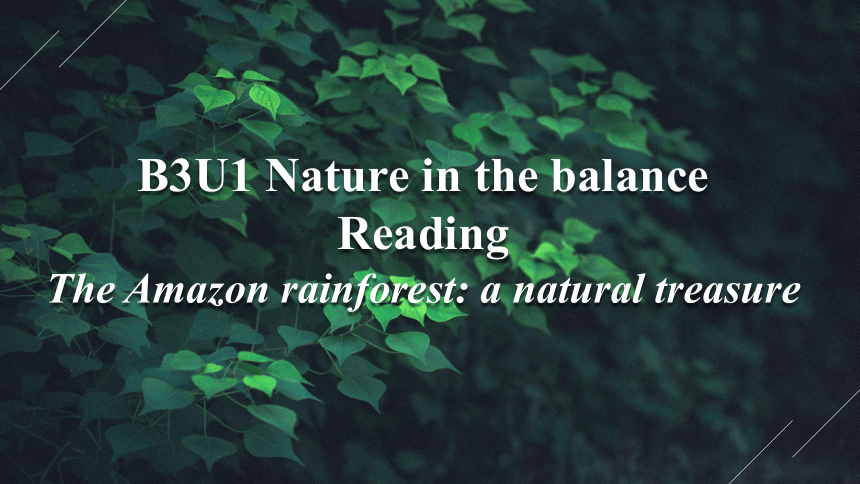 | |
| 格式 | pptx | ||
| 文件大小 | 6.7MB | ||
| 资源类型 | 教案 | ||
| 版本资源 | 牛津译林版(2019) | ||
| 科目 | 英语 | ||
| 更新时间 | 2024-05-22 10:42:51 | ||
图片预览



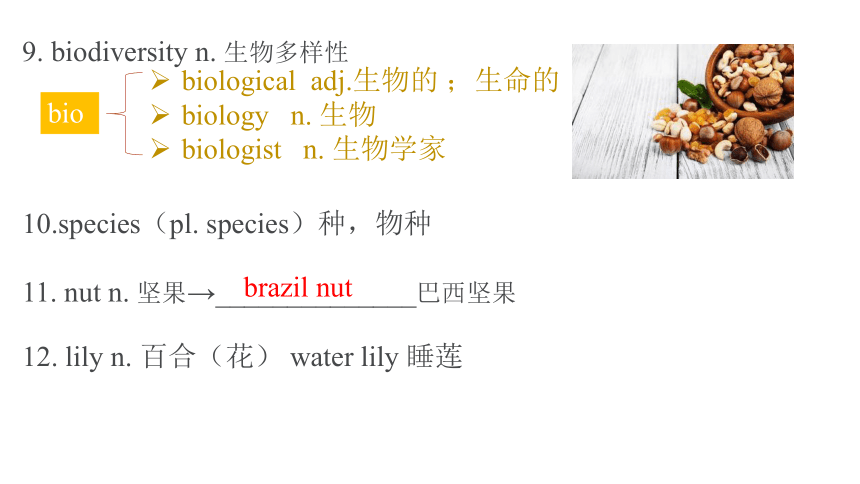
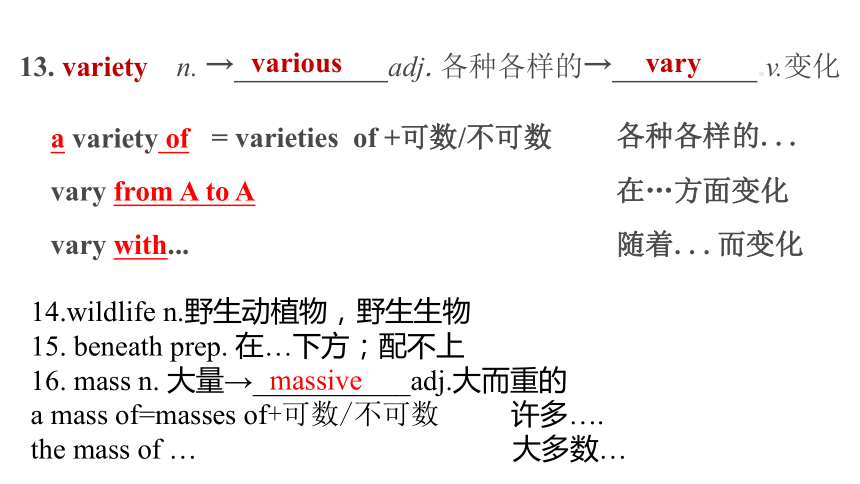
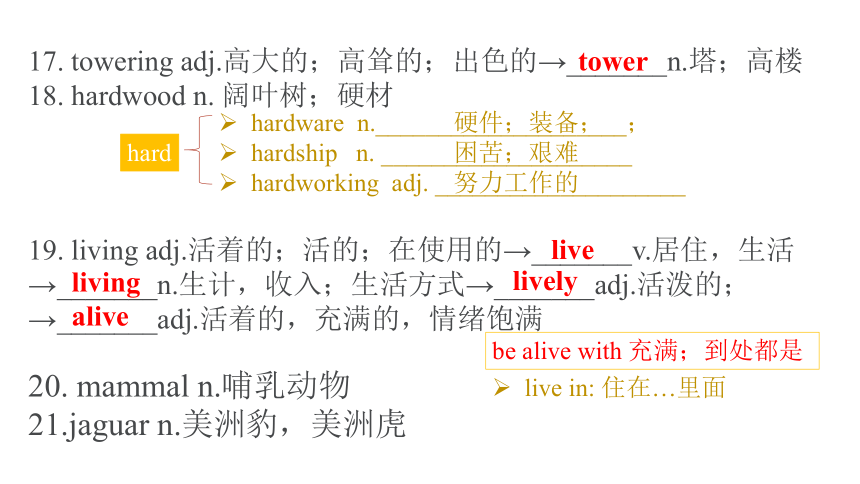

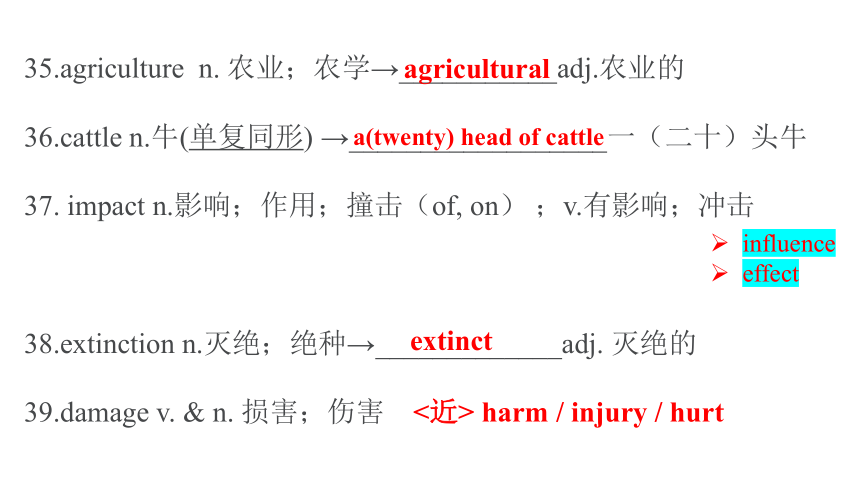
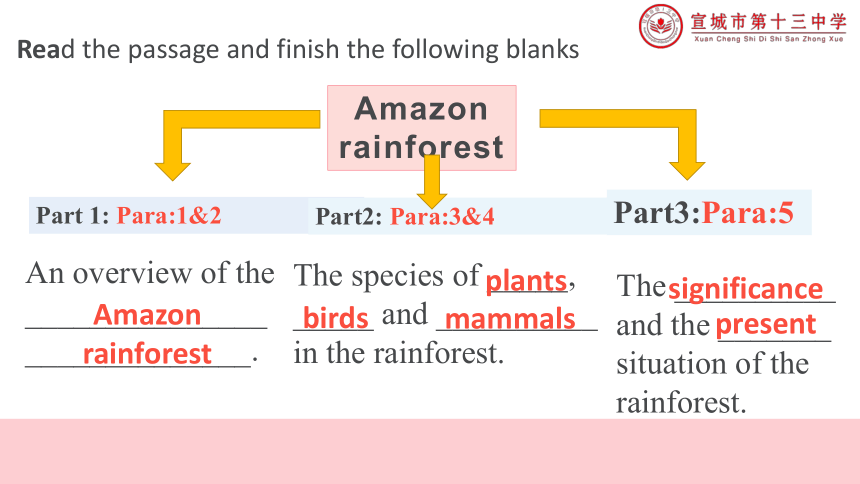
文档简介
(共22张PPT)
B3U1 Nature in the balance
Reading
The Amazon rainforest: a natural treasure
harm n.伤害,损害(to)→ _______v.伤害,损害→_______ adj.有害的→__________ adj.无害的
do harmto=be harmful to 对...有害
2. soil n. 土地;土壤;国土;领土
3.ecosystem n. 生态系统
4. overseas adj.海外的,国外的→ ________adv. → <近>________ → <反>_______
harm
harmful
overseas
abroad
domestic
harmless
5. region n. 地区,区域,行政区→________ adj.地区的,区域的
6. continent n.大陆,陆地,州
7.million num. 一百万,许多,大量
8. length n.长,度 → _______ adj.长的→ ______ n.宽→______ n.高
(美洲)____________
亚洲___________
大洋洲____________
非洲__________
(欧洲)___________
Africa
America
Asia
Europe
Oceania
百:___________ 千:___________ 万:_______________
十万:___________________ 百万:___________ 千万:______________
regional
hundred
thousand
ten thousand
hundred thousand
million
ten million
long
width
height
9. biodiversity n. 生物多样性
10.species(pl. species)种,物种
11. nut n. 坚果→______________巴西坚果
12. lily n. 百合(花) water lily 睡莲
bio
biological adj.生物的 ;生命的
biology n. 生物
biologist n. 生物学家
brazil nut
13. variety n. → adj. 各种各样的→ .v.变化
various
vary
各种各样的...
a variety of
= varieties of +可数/不可数
vary from A to A
在…方面变化
vary with...
随着...而变化
14.wildlife n.野生动植物,野生生物
15. beneath prep. 在…下方;配不上
16. mass n. 大量→___________adj.大而重的
a mass of=masses of+可数/不可数 许多….
the mass of … 大多数…
massive
17. towering adj.高大的;高耸的;出色的→_______n.塔;高楼
18. hardwood n. 阔叶树;硬材
19. living adj.活着的;活的;在使用的→_______v.居住,生活→_______n.生计,收入;生活方式→_______adj.活泼的; →_______adj.活着的,充满的,情绪饱满
20. mammal n.哺乳动物
21.jaguar n.美洲豹,美洲虎
hard
hardware n.____________________;
hardship n. ____________________
hardworking adj. ____________________
live in: 住在…里面
tower
live
living
lively
alive
be alive with 充满;到处都是
硬件;装备;
困苦;艰难
努力工作的
22. survive vi.生存;存活;vt. 幸存;幸免遇难→_______n.幸存→;→_________幸存者;
26. microorganism n.微生物;
28.nutrient n. 营养物;营养素→_________n.营养;营养学;
30.carbon n. 碳→_______________n.低碳
31. oxygen n.氧;氧气
32.thus adv.因此,从而;这样
33. disappear v.消失,灭绝→_____________n.消失
micro
Microsoft n._____________;
microphone n. _________
survival
survivor
nutrition
low carbon
disappearance
微软公司;
麦克风
35.agriculture n. 农业;农学→___________adj.农业的
36.cattle n.牛(单复同形) →__________________一(二十)头牛
37. impact n.影响;作用;撞击(of, on) ;v.有影响;冲击
38.extinction n.灭绝;绝种→_____________adj. 灭绝的
39.damage v. & n. 损害;伤害
agricultural
a(twenty) head of cattle
influence
effect
extinct
<近> harm / injury / hurt
Amazon rainforest
Part 1: Para:1&2
Part2: Para:3&4
Part3:Para:5
An overview of the _____________________________.
The species of _____, _____ and __________ in the rainforest.
The __________ and the _______ situation of the rainforest.
Amazon
rainforest
plants
birds
mammals
significance
present
Read the passage and finish the following blanks
Part 1: An overview of the Amazon rainforest
Para. 1: ______________ to the Amazon rainforest
Para. 2: Basic ______________ about the rainforest
Introduction
It crosses into _____ countries.
It has an area of around __ million square kilometers.
It is more than _____ size of China.
The Amazon river supports many different ______________.
information
8
6
half
ecosystems
Guidance & Exploration
Part 2: The species of plants, birds and mammals
in the rainforest.
Para. 3: _______ in the Amazon rainforest
Read para. 3 try to understand the rainforest’s different levels.
a system of roots
the tops of the tallest trees
the mass of leaf litter
shorter plants with large leaves
towering ancient hardwoods
Plants
Jaguars
Insects
At least 87 species, including frogs
Leaves and fruit
Microorganisms
feed on
break down
feed on
feed on
Part 2: The species of plants, birds and mammals in the rainforest.
Para. 4: __________ in the Amazon rainforest
Read and complete the chart about the food chain in the rainforest.
Mammals
Part 3: The significance and the present situation of the rainforest.
Read paragraph 5 and find the answer:
It is often known as the ______________________.
Significance:
Present situation:
___ per cent of the rainforest has disappeared ______human activities.
“lungs of the planet”
17
due to
B3U1 Nature in balance
The Amazon rainforest: a natural treasure
The Amazon rainforest:a natural treasure
Welcome to the jungle, a huge sea of green alive with the sounds of animals. This is the Amazon rainforest. As the largest rainforest in the world, it plays a significant role in maintaining the fine balance of the Earth's ecosystem.
欢迎来到丛林,这是一片绿色的海洋,处处可闻各种动物的声音。这里是亚马孙雨林。作为世界上最大的雨林,它在维系地球生态系统的微妙平衡上扮演着举足轻重的角色。
Reading
The Amazon rainforest crosses into eight countries, including Brazil and Peru, and one overseas region of France, all on South American continent. With an area of around 6 million square kilometres, the Amazon rainforest is more than half the size of China. The Amazon River, from which the rainforest gets its name, is close to 6,400 kilometres in length—roughly 100 kilometres longer than the Yangtze River.
亚马孙雨林穿过包括巴西和秘鲁在内的八个国家,以及一块法国的海外领地,都位于南美洲大陆。亚马孙雨林面积约600万平方千米,比中国国土面积的一半还要大。亚马孙雨林得名于亚马孙河,亚马孙河长约6 400千米,比长江还长大约100千米。
On its journey from the mountains to the ocean, the river supports many different ecosystems. They give this area the richest biodiversity on the Earth: one in ten known species in the world can be found here.
这条河从高山流向海洋,沿途维系着多种不同的生态系统。它们赋予这片区域地球上最丰富的生物多样性:全世界十分之一的已知物种都可以在这里找到。
Of the 390,000 plant species known to us, more than 40,000 can be found in the Amazon. This tall and ancient brazil nut tree produces nuts that we can eat; these water lilies are big enough to lie down on. The forest's different levels support an unbelievable variety of wildlife. At the bottom, there is a system of roots beneath the ground. Above that is the mass of leaf litter on the dark forest floor. The next level is made up of shorter plants with large leaves.
在人类已知的390 000种植物种中,在亚马孙可以找到40 000多种。这棵高大、古老的巴西坚果树结出的坚果我们可以食用;这些睡莲(叶片)大到可以躺在上面。雨林的不同层次养活的野生动物种类多到难以置信。最底层是地下的根系。往上是阴暗森林地表厚实的落叶层。再往上一层由低矮的阔叶植物组成。
Then there are the towering ancient hardwoods, and finally the tops of tallest trees many metres above the ground. Each level of the forest forms its own little world, home to different kinds of living things.
然后是那些离地数米之高的大树的树冠。雨林的每一层都自成一个小世界,成为各种生物的家园。
More than 1,300 species of birds and over 400 species of mammals hide among the jungle's plant life. This jaguar is one example. It has a yellowish brown coat with black spots. While a significant number of jaguars survive here , they are only one element of this forest's food chain. They feed on at least 87 species, including frogs. These frogs, in turn, feed on insects which eat leaves and fruit. When a jaguar dies, a tiny army of microorganisms helps break down its body and return the nutrients to the earth.
1 300多种鸟和400多种哺乳动物藏身于这片丛林的植被中。这只美洲豹就是个例子。它黄棕色的皮毛上遍布着黑点。尽管这里生存着数量可观的美洲豹,但它们仅仅是雨林食物链上的一环。它们捕食的物种至少有87种,其中包括青蛙。相应地,这些青蛙的食物,是以树叶和水果为食的昆虫。美洲豹死亡后,一小群微生物会助力其尸体的分解,让营养素重回土壤之中。
The Amazon rainforest breathes life into the planet by fixing carbon and producing over 20 per cent of all the Earth's oxygen. Thus, it is often known as the “lungs of the planet”. Moreover, the Amazon rainforest is a treasure house of species that can be used for food or medicine.
亚马孙雨林通过固定碳(二氧化碳——译者注),并生成占全球总量20%以上的氧气,来为地球注入活力。因此,它也常常被称作“地球之肺”。此外,亚马孙雨林还是食用物种和药用物种的宝库。
Yet there is one major danger to these irreplaceable plants and animals: us. Over the past 50 years, about 17 per cent of the rainforest has disappeared due to human activities such as agriculture and cattle farming. As the impact of human activities continues to grow and the list of species in danger of extinction becomes longer, we are left with a question: can we afford to damage the “lungs of the planet”
然而,这些无可取代的动植物面临的一个主要威胁就是:我们。在过去的50年里,由于农耕和养牛等人类活动,大约17%的雨林已经消失了。随着人类活动影响的不断增加,濒危物种的名单越来越长,这留给我们一个问题:我们能承担得起损害“地球之肺”的后果吗?
B3U1 Nature in the balance
Reading
The Amazon rainforest: a natural treasure
harm n.伤害,损害(to)→ _______v.伤害,损害→_______ adj.有害的→__________ adj.无害的
do harmto=be harmful to 对...有害
2. soil n. 土地;土壤;国土;领土
3.ecosystem n. 生态系统
4. overseas adj.海外的,国外的→ ________adv. → <近>________ → <反>_______
harm
harmful
overseas
abroad
domestic
harmless
5. region n. 地区,区域,行政区→________ adj.地区的,区域的
6. continent n.大陆,陆地,州
7.million num. 一百万,许多,大量
8. length n.长,度 → _______ adj.长的→ ______ n.宽→______ n.高
(美洲)____________
亚洲___________
大洋洲____________
非洲__________
(欧洲)___________
Africa
America
Asia
Europe
Oceania
百:___________ 千:___________ 万:_______________
十万:___________________ 百万:___________ 千万:______________
regional
hundred
thousand
ten thousand
hundred thousand
million
ten million
long
width
height
9. biodiversity n. 生物多样性
10.species(pl. species)种,物种
11. nut n. 坚果→______________巴西坚果
12. lily n. 百合(花) water lily 睡莲
bio
biological adj.生物的 ;生命的
biology n. 生物
biologist n. 生物学家
brazil nut
13. variety n. → adj. 各种各样的→ .v.变化
various
vary
各种各样的...
a variety of
= varieties of +可数/不可数
vary from A to A
在…方面变化
vary with...
随着...而变化
14.wildlife n.野生动植物,野生生物
15. beneath prep. 在…下方;配不上
16. mass n. 大量→___________adj.大而重的
a mass of=masses of+可数/不可数 许多….
the mass of … 大多数…
massive
17. towering adj.高大的;高耸的;出色的→_______n.塔;高楼
18. hardwood n. 阔叶树;硬材
19. living adj.活着的;活的;在使用的→_______v.居住,生活→_______n.生计,收入;生活方式→_______adj.活泼的; →_______adj.活着的,充满的,情绪饱满
20. mammal n.哺乳动物
21.jaguar n.美洲豹,美洲虎
hard
hardware n.____________________;
hardship n. ____________________
hardworking adj. ____________________
live in: 住在…里面
tower
live
living
lively
alive
be alive with 充满;到处都是
硬件;装备;
困苦;艰难
努力工作的
22. survive vi.生存;存活;vt. 幸存;幸免遇难→_______n.幸存→;→_________幸存者;
26. microorganism n.微生物;
28.nutrient n. 营养物;营养素→_________n.营养;营养学;
30.carbon n. 碳→_______________n.低碳
31. oxygen n.氧;氧气
32.thus adv.因此,从而;这样
33. disappear v.消失,灭绝→_____________n.消失
micro
Microsoft n._____________;
microphone n. _________
survival
survivor
nutrition
low carbon
disappearance
微软公司;
麦克风
35.agriculture n. 农业;农学→___________adj.农业的
36.cattle n.牛(单复同形) →__________________一(二十)头牛
37. impact n.影响;作用;撞击(of, on) ;v.有影响;冲击
38.extinction n.灭绝;绝种→_____________adj. 灭绝的
39.damage v. & n. 损害;伤害
agricultural
a(twenty) head of cattle
influence
effect
extinct
<近> harm / injury / hurt
Amazon rainforest
Part 1: Para:1&2
Part2: Para:3&4
Part3:Para:5
An overview of the _____________________________.
The species of _____, _____ and __________ in the rainforest.
The __________ and the _______ situation of the rainforest.
Amazon
rainforest
plants
birds
mammals
significance
present
Read the passage and finish the following blanks
Part 1: An overview of the Amazon rainforest
Para. 1: ______________ to the Amazon rainforest
Para. 2: Basic ______________ about the rainforest
Introduction
It crosses into _____ countries.
It has an area of around __ million square kilometers.
It is more than _____ size of China.
The Amazon river supports many different ______________.
information
8
6
half
ecosystems
Guidance & Exploration
Part 2: The species of plants, birds and mammals
in the rainforest.
Para. 3: _______ in the Amazon rainforest
Read para. 3 try to understand the rainforest’s different levels.
a system of roots
the tops of the tallest trees
the mass of leaf litter
shorter plants with large leaves
towering ancient hardwoods
Plants
Jaguars
Insects
At least 87 species, including frogs
Leaves and fruit
Microorganisms
feed on
break down
feed on
feed on
Part 2: The species of plants, birds and mammals in the rainforest.
Para. 4: __________ in the Amazon rainforest
Read and complete the chart about the food chain in the rainforest.
Mammals
Part 3: The significance and the present situation of the rainforest.
Read paragraph 5 and find the answer:
It is often known as the ______________________.
Significance:
Present situation:
___ per cent of the rainforest has disappeared ______human activities.
“lungs of the planet”
17
due to
B3U1 Nature in balance
The Amazon rainforest: a natural treasure
The Amazon rainforest:a natural treasure
Welcome to the jungle, a huge sea of green alive with the sounds of animals. This is the Amazon rainforest. As the largest rainforest in the world, it plays a significant role in maintaining the fine balance of the Earth's ecosystem.
欢迎来到丛林,这是一片绿色的海洋,处处可闻各种动物的声音。这里是亚马孙雨林。作为世界上最大的雨林,它在维系地球生态系统的微妙平衡上扮演着举足轻重的角色。
Reading
The Amazon rainforest crosses into eight countries, including Brazil and Peru, and one overseas region of France, all on South American continent. With an area of around 6 million square kilometres, the Amazon rainforest is more than half the size of China. The Amazon River, from which the rainforest gets its name, is close to 6,400 kilometres in length—roughly 100 kilometres longer than the Yangtze River.
亚马孙雨林穿过包括巴西和秘鲁在内的八个国家,以及一块法国的海外领地,都位于南美洲大陆。亚马孙雨林面积约600万平方千米,比中国国土面积的一半还要大。亚马孙雨林得名于亚马孙河,亚马孙河长约6 400千米,比长江还长大约100千米。
On its journey from the mountains to the ocean, the river supports many different ecosystems. They give this area the richest biodiversity on the Earth: one in ten known species in the world can be found here.
这条河从高山流向海洋,沿途维系着多种不同的生态系统。它们赋予这片区域地球上最丰富的生物多样性:全世界十分之一的已知物种都可以在这里找到。
Of the 390,000 plant species known to us, more than 40,000 can be found in the Amazon. This tall and ancient brazil nut tree produces nuts that we can eat; these water lilies are big enough to lie down on. The forest's different levels support an unbelievable variety of wildlife. At the bottom, there is a system of roots beneath the ground. Above that is the mass of leaf litter on the dark forest floor. The next level is made up of shorter plants with large leaves.
在人类已知的390 000种植物种中,在亚马孙可以找到40 000多种。这棵高大、古老的巴西坚果树结出的坚果我们可以食用;这些睡莲(叶片)大到可以躺在上面。雨林的不同层次养活的野生动物种类多到难以置信。最底层是地下的根系。往上是阴暗森林地表厚实的落叶层。再往上一层由低矮的阔叶植物组成。
Then there are the towering ancient hardwoods, and finally the tops of tallest trees many metres above the ground. Each level of the forest forms its own little world, home to different kinds of living things.
然后是那些离地数米之高的大树的树冠。雨林的每一层都自成一个小世界,成为各种生物的家园。
More than 1,300 species of birds and over 400 species of mammals hide among the jungle's plant life. This jaguar is one example. It has a yellowish brown coat with black spots. While a significant number of jaguars survive here , they are only one element of this forest's food chain. They feed on at least 87 species, including frogs. These frogs, in turn, feed on insects which eat leaves and fruit. When a jaguar dies, a tiny army of microorganisms helps break down its body and return the nutrients to the earth.
1 300多种鸟和400多种哺乳动物藏身于这片丛林的植被中。这只美洲豹就是个例子。它黄棕色的皮毛上遍布着黑点。尽管这里生存着数量可观的美洲豹,但它们仅仅是雨林食物链上的一环。它们捕食的物种至少有87种,其中包括青蛙。相应地,这些青蛙的食物,是以树叶和水果为食的昆虫。美洲豹死亡后,一小群微生物会助力其尸体的分解,让营养素重回土壤之中。
The Amazon rainforest breathes life into the planet by fixing carbon and producing over 20 per cent of all the Earth's oxygen. Thus, it is often known as the “lungs of the planet”. Moreover, the Amazon rainforest is a treasure house of species that can be used for food or medicine.
亚马孙雨林通过固定碳(二氧化碳——译者注),并生成占全球总量20%以上的氧气,来为地球注入活力。因此,它也常常被称作“地球之肺”。此外,亚马孙雨林还是食用物种和药用物种的宝库。
Yet there is one major danger to these irreplaceable plants and animals: us. Over the past 50 years, about 17 per cent of the rainforest has disappeared due to human activities such as agriculture and cattle farming. As the impact of human activities continues to grow and the list of species in danger of extinction becomes longer, we are left with a question: can we afford to damage the “lungs of the planet”
然而,这些无可取代的动植物面临的一个主要威胁就是:我们。在过去的50年里,由于农耕和养牛等人类活动,大约17%的雨林已经消失了。随着人类活动影响的不断增加,濒危物种的名单越来越长,这留给我们一个问题:我们能承担得起损害“地球之肺”的后果吗?
同课章节目录
- Unit 1 Nature in the balance
- Welcome to the unit
- Reading
- Grammar and usage
- Integrated skills
- Extended reading
- Project
- Unit 2 Natural disasters
- Welcome to the unit
- Reading
- Grammar and usage
- Integrated skills
- Extended reading
- Project
- Unit 3 The world online
- Welcome to the unit
- Reading
- Grammar and usage
- Integrated skills
- Extended reading
- Project
- Unit 4 Scientists who changed the world
- Welcome to the unit
- Reading
- Grammar and usage
- Integrated skills
- Extended reading
- Project
